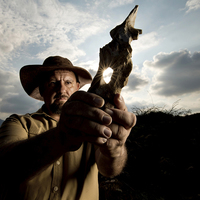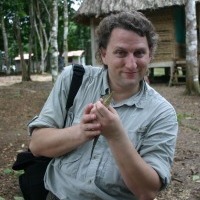
John Hutchinson
I'm an American biologist who has found a new home in the UK. I got my BS degree in Zoology at the University of Wisconsin in 1993, then received my PhD in Integrative Biology at the University of California with Kevin Padian in 2001, and rounded out my training with a two-year National Science Foundation bioinformatics Post Doc at the Biomechanical Engineering Division of Stanford University with Scott Delp.
I started at the RVC as a Lecturer in Evolutionary Biomechanics in 2003 in the Department of Veterinary Basic Sciences (now Department of Comparative Biomedical Sciences) and was promoted to Reader in 2008, then Professor of Evolutionary Biomechanics in 2011. My interests are in the evolutionary biomechanics of locomotion, especially in large terrestrial vertebrates. I've studied birds, extinct dinosaurs and their relatives, elephants, crocodiles, early tetrapods like Ichthyostega, and many more species. I am an Associate Editor for Proceedings of the Royal Society B (Biological Sciences) and the open access journal PeerJ. Since 2014, I have been an Honorary Professor at the University of Queensland- http://www.uq.edu.au/sbms/front-page
I have a science blog! http://whatsinjohnsfreezer.com/
Phone: +44 (0)1707 666 313
Address: Dr. John R. Hutchinson
Professor of Evolutionary Biomechanics
Department of Comparative Biomedical Sciences
Structure & Motion Laboratory
The Royal Veterinary College
University of London
Hatfield, Herts AL9 7TA
United Kingdom
BUT this is my personal page, not directly affiliated with RVC or others. Views are my own.
I started at the RVC as a Lecturer in Evolutionary Biomechanics in 2003 in the Department of Veterinary Basic Sciences (now Department of Comparative Biomedical Sciences) and was promoted to Reader in 2008, then Professor of Evolutionary Biomechanics in 2011. My interests are in the evolutionary biomechanics of locomotion, especially in large terrestrial vertebrates. I've studied birds, extinct dinosaurs and their relatives, elephants, crocodiles, early tetrapods like Ichthyostega, and many more species. I am an Associate Editor for Proceedings of the Royal Society B (Biological Sciences) and the open access journal PeerJ. Since 2014, I have been an Honorary Professor at the University of Queensland- http://www.uq.edu.au/sbms/front-page
I have a science blog! http://whatsinjohnsfreezer.com/
Phone: +44 (0)1707 666 313
Address: Dr. John R. Hutchinson
Professor of Evolutionary Biomechanics
Department of Comparative Biomedical Sciences
Structure & Motion Laboratory
The Royal Veterinary College
University of London
Hatfield, Herts AL9 7TA
United Kingdom
BUT this is my personal page, not directly affiliated with RVC or others. Views are my own.
less
Related Authors
Julian D Reynolds
Trinity College Dublin
Anna Dornhaus
University of Arizona
Sebahattin Devecioglu
University of Firat
Kristen J Gremillion
Ohio State University
David Seamon
Kansas State University
Jose Ruben Guzman-Gutierrez
Universidad Humanista de las Americas
Armando Marques-Guedes
UNL - New University of Lisbon
Giulia Sissa
Ucla
Thomas Holtz
University of Maryland
Gwen Robbins Schug
University of North Carolina at Greensboro
InterestsView All (14)










Uploads
Papers by John Hutchinson
(Rhinoceros unicornis), and Sumatran (Dicerorhinus sumatrensis) rhinoceroses are kept in captivity worldwide, where
they are a popular public attraction and serve important roles in education and conservation. Rhinoceroses in
captivity are reportedly affected by a variety of foot conditions, including abscesses, nail cracking, and
pododermatitis, but there are few studies reporting associated bony pathology in these species. This study aimed
to describe osteopathology in rhinoceros feet and identify normal and abnormal osteologic features of rhinoceros
feet. The metacarpal-tarsal and phalangeal bones from 81 feet (67 skeletal specimens and 14 cadaveric feet),
derived from 27 rhinoceroses of various species, were evaluated in the study (1 black, 11 white, 2 greater onehorned,
3 Javan, 9 Sumatran, and 1 unknown). Bones were examined visually (skeletal specimens) or by computed
tomography (cadaver specimens) for evidence of bony lesions. Of the 27 rhinoceroses examined, 22 showed some
degree of bone pathology in at least one limb. Six broad categories of pathologic change were identified, with
numbers in parentheses representing numbers of rhinoceroses with lesions in at least one limb/number of
rhinoceroses examined: enthesopathy (20/27), osteoarthritis (15/27), pathologic bone remodeling (12/27),
osteitis-osteomyelitis (3/27), fracture (3/8), and subluxation (3/8). The frequency of pathologic changes in foreand
hind limbs was not significantly different. Most (91%) enthesopathies were observed on the proximal
phalanges of the digits, and osteoarthritis was most common in the distal interphalangeal joints of the medial and
lateral digits (32 and 26%, respectively). In addition to the pathology described, all examined rhinoceroses also
had multiple small surface lucencies in the distal limb bones as an apparently normal anatomic feature. This study
is an important first step in identifying both normal and pathologic features of rhinoceros feet and hopefully will
thereby contribute to the improved knowledge and care of these species.
femorofibular, and femoropatellar) joint has scarcely been studied, and could elucidate
certain mechanobiological properties of sesamoid bones. The adult ostrich
is unique in that it has double patellae, while another similar ratite bird, the emu,
has none. Understanding why these patellae form and what purpose they may serve
is dually important for future studies on ratites as well as for understanding the
mechanobiological characteristics of sesamoid bone development. For this purpose,
we present a three-dimensional anatomical study of the ostrich knee joint, detailing
osteology, ligaments and menisci, and myology. We have identified seven muscles
which connect to the two patellae and compare our findings to past descriptions.
These descriptions can be used to further study the biomechanical loading and
implications of the double patella in the ostrich.
because it is closely linked to manifold life history and ecological traits and
is readily estimable for many extinct taxa. In this study, we examine patterns
of body mass evolution in Felidae (Placentalia, Carnivora) to assess the
effects of phylogeny, mode of evolution, and the relationship between body
mass and prey choice in this charismatic mammalian clade. Our data set
includes 39 extant and 26 extinct taxa, with published body mass data supplemented
by estimates based on condylobasal length. These data were run
through ‘SURFACE’ and ‘bayou’ to test for patterns of body mass evolution
and convergence between taxa. Body masses of felids are significantly different
among prey choice groupings (small, mixed and large). We find that
body mass evolution in cats is strongly influenced by phylogeny, but different
patterns emerged depending on inclusion of extinct taxa and assumptions
about branch lengths. A single Ornstein–Uhlenbeck optimum best
explains the distribution of body masses when first-occurrence data were
used for the fossil taxa. However, when mean occurrence dates or last
known occurrence dates were used, two selective optima for felid body mass
were recovered in most analyses: a small optimum around 5 kg and a large
one around 100 kg. Across living and extinct cats, we infer repeated evolutionary
convergences towards both of these optima, but, likely due to biased
extinction of large taxa, our results shift to supporting a Brownian motion
model when only extant taxa are included in analyses.
(Rhinoceros unicornis), and Sumatran (Dicerorhinus sumatrensis) rhinoceroses are kept in captivity worldwide, where
they are a popular public attraction and serve important roles in education and conservation. Rhinoceroses in
captivity are reportedly affected by a variety of foot conditions, including abscesses, nail cracking, and
pododermatitis, but there are few studies reporting associated bony pathology in these species. This study aimed
to describe osteopathology in rhinoceros feet and identify normal and abnormal osteologic features of rhinoceros
feet. The metacarpal-tarsal and phalangeal bones from 81 feet (67 skeletal specimens and 14 cadaveric feet),
derived from 27 rhinoceroses of various species, were evaluated in the study (1 black, 11 white, 2 greater onehorned,
3 Javan, 9 Sumatran, and 1 unknown). Bones were examined visually (skeletal specimens) or by computed
tomography (cadaver specimens) for evidence of bony lesions. Of the 27 rhinoceroses examined, 22 showed some
degree of bone pathology in at least one limb. Six broad categories of pathologic change were identified, with
numbers in parentheses representing numbers of rhinoceroses with lesions in at least one limb/number of
rhinoceroses examined: enthesopathy (20/27), osteoarthritis (15/27), pathologic bone remodeling (12/27),
osteitis-osteomyelitis (3/27), fracture (3/8), and subluxation (3/8). The frequency of pathologic changes in foreand
hind limbs was not significantly different. Most (91%) enthesopathies were observed on the proximal
phalanges of the digits, and osteoarthritis was most common in the distal interphalangeal joints of the medial and
lateral digits (32 and 26%, respectively). In addition to the pathology described, all examined rhinoceroses also
had multiple small surface lucencies in the distal limb bones as an apparently normal anatomic feature. This study
is an important first step in identifying both normal and pathologic features of rhinoceros feet and hopefully will
thereby contribute to the improved knowledge and care of these species.
femorofibular, and femoropatellar) joint has scarcely been studied, and could elucidate
certain mechanobiological properties of sesamoid bones. The adult ostrich
is unique in that it has double patellae, while another similar ratite bird, the emu,
has none. Understanding why these patellae form and what purpose they may serve
is dually important for future studies on ratites as well as for understanding the
mechanobiological characteristics of sesamoid bone development. For this purpose,
we present a three-dimensional anatomical study of the ostrich knee joint, detailing
osteology, ligaments and menisci, and myology. We have identified seven muscles
which connect to the two patellae and compare our findings to past descriptions.
These descriptions can be used to further study the biomechanical loading and
implications of the double patella in the ostrich.
because it is closely linked to manifold life history and ecological traits and
is readily estimable for many extinct taxa. In this study, we examine patterns
of body mass evolution in Felidae (Placentalia, Carnivora) to assess the
effects of phylogeny, mode of evolution, and the relationship between body
mass and prey choice in this charismatic mammalian clade. Our data set
includes 39 extant and 26 extinct taxa, with published body mass data supplemented
by estimates based on condylobasal length. These data were run
through ‘SURFACE’ and ‘bayou’ to test for patterns of body mass evolution
and convergence between taxa. Body masses of felids are significantly different
among prey choice groupings (small, mixed and large). We find that
body mass evolution in cats is strongly influenced by phylogeny, but different
patterns emerged depending on inclusion of extinct taxa and assumptions
about branch lengths. A single Ornstein–Uhlenbeck optimum best
explains the distribution of body masses when first-occurrence data were
used for the fossil taxa. However, when mean occurrence dates or last
known occurrence dates were used, two selective optima for felid body mass
were recovered in most analyses: a small optimum around 5 kg and a large
one around 100 kg. Across living and extinct cats, we infer repeated evolutionary
convergences towards both of these optima, but, likely due to biased
extinction of large taxa, our results shift to supporting a Brownian motion
model when only extant taxa are included in analyses.